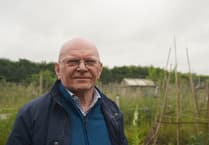OBITUARY
Jean Kathleen Bowden
August 22, 1930-January 27, 2017
WHEN Jean died in Anstey Ward of Alton Community Hospital on January 27, few would have guessed at the long and interesting life that she had lived.
Jean was born 86 years ago at Waddon in Surrey. At age 11, she gained a place to Nonsuch County School for Girls in Cheam (named after the Tudor palace). This was in 1941, so her education was interrupted, either by spending hours in the school’s air-raid shelter or by enjoyable months evacuated to her aunt and uncle’s home in Gloucestershire where she was thoroughly spoiled.
Leaving Nonsuch at 18, with Higher School Certificates in the natural sciences, Jean then wrote to The Royal Botanical Gardens at Kew. Despite their initial doubts that she was capable of cycling 20 miles per day, six days per week, they gave her work mounting dried plant specimens for storage in the herbarium. These plants were sent into Kew by collectors from around the world to be studied by the Kew botanists.
She was promoted to this post of assistant scientific officer in the Kew Museums of Economic Botany and spent the next 10 years looking after their huge collections.
At the same time, she spent time attending day and evening classes and writing essays and reading every weekend. Although this left no time for a social life, Jean loved the study of botany, zoology and geology. She was also given leave to attend residential field study courses.
On gaining her Bachelor of Science degree from London University, Jean was promoted to higher scientific officer with a pay rise and six weeks annual leave. However, there was no post of that grade available in the museums so she was offered a post in the orchid department at the herbarium where she spent the next 10 years working on the orchids of the world – possibly the largest of all the plant families.
During that time she was invited to go on a four-month plant-collecting trip to Nigeria by a visiting American professor and his wife from the Ile Ife University, when she learned that Kew had never previously sent women on their field trips.
Jean was there in 1970, just at the end of the Biafran War. During this time she went with a small group of botanists right across Nigeria, from Ibadan in the west to the Cameroon Mountains in the East. She collected many living orchid plants and also pressed specimens for the gardens and the herbarium. They stayed overnight in mud huts in tiny villages in the bush.
Back at Kew, Jean identified all her collections. A few years later, she moved to other departments and worked on different plant families, but they never seemed as fascinating as the orchids.
After discovering bundles of British plants collected by Reverend John Lightfoot (1735-1788) in the 18th Century, which had somehow been overlooked, Jean sorted them out and became interested in his careful labelling with details of habitats, which at that time was unusual.
Also he had published a flora of Scotland in English rather than Latin as he said he wanted ordinary people to be able to identify medicinal and edible plants. His book Flora Scotica (1777) was published after he had toured Scotland’s Highlands and Islands with eminent zoologist Thomas Pennant in 1772, the year before the well known tour of the Hebrides by Dr Boswell and Dr Johnson.
However, apart from an obituary, Jean could discover nothing more about John Lightfoot, and she researched various archives. She was lucky enough to find letters between him and eminent botanists such as Sir Joseph Banks and other friends, and what was intended to be a paper about him turned into a book, published in 1989 by Kew and Carnegie Mellon University, Pittsburgh.
Jean was thrilled to discover that Lightfoot and Gilbert White were friends and that Lightfoot’s first living (1765-1777) had been at Shalden, near Alton.
After that, Jean worked in the editorial department of the Kew Bulletin 1984 where, at the annual meeting of the Jane Austen Society at Chawton, it was announced that the Jane Austen Memorial Trust at Jane Austen’s House needed a new curator.
Jean, a lifetime devotee of Jane Austen and her works, and in need of a complete change after the death of her parents and her brother in just one year, applied for the post and in September 1984 she moved into Jane Austen’s House with her beloved cat, William.
Thus began what were to be the happiest 10 years of Jean’s life. She wanted to forge a closer relationship with the Jane Austen Society of North America, and after giving a talk at their meeting in Washington DC, she was asked to contribute a “Letter from Chawton” twice a year; re-reading her 1990 letter which you can easily find online, Jean did indeed write fully and beautifully.
The US Janeites took a great interest in the house, generously donating enough money for the restoration of Jane Austen’s donkey carriage and her collection of manuscript music books among other things.
During Jean’s time at Chawton, the house was restored, some barns altered internally to become a much-needed lecture room and an office; a back room became a successful bookshop, whither some of Jean’s books will be bound (others going to The Wakes and the church here). When the last of the oak trees outside the garden wall, apparently planted by Jane Austen herself, was cut down, Jean rescued a self-sown seedling and planted it in the garden. Twenty years later, Jean had the pleasure of having a tea party beneath it. Curiously, the story of Jean and the oak was mentioned on gardener’s question time in the week she died.
Jean retired in 1994 to Primrose Cottage on Gracious Street, Selborne, enjoying many happy years in this lovely, friendly village and well supported by neighbours and friends. The last few years were frustrating to Jean who had increasingly lost her sight and her mobility so severely.
She will be much missed in this church and community of which she was so much a part.
(Obituary courtesy of the magazine of Newton Valence, Selborne and Colemore)

-and-Mark-Hurst-(left)-from-Haslemere-and-District.jpeg?width=209&height=140&crop=209:145,smart&quality=75)



Comments
This article has no comments yet. Be the first to leave a comment.